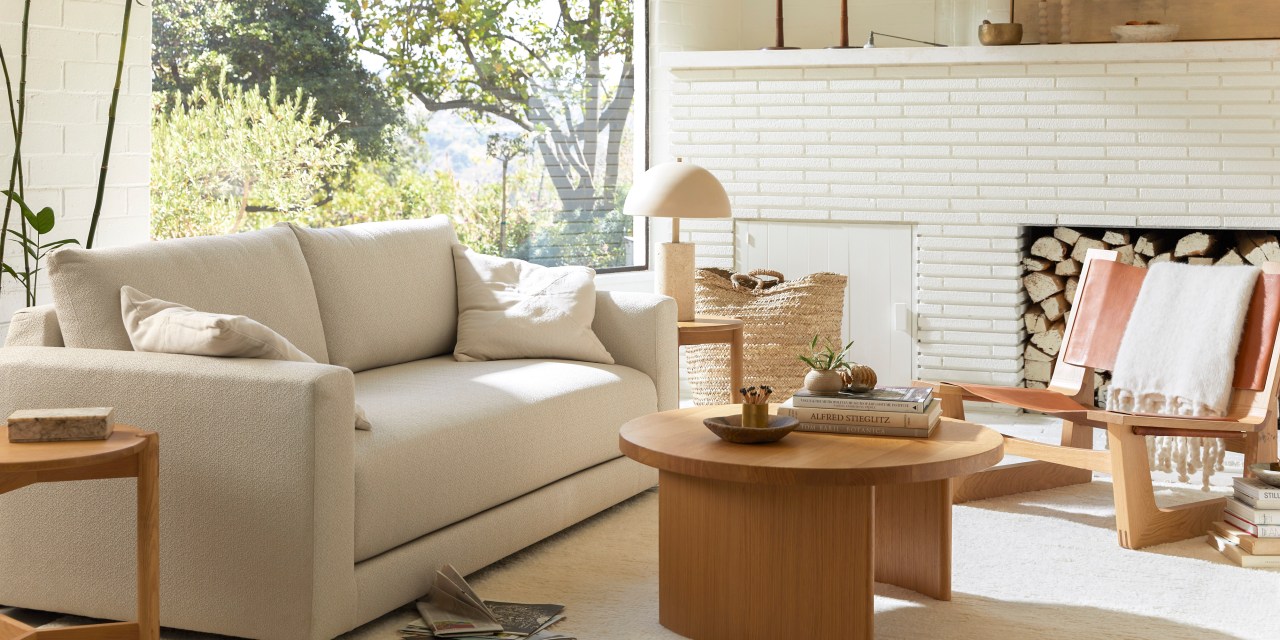Parachute launches living room collection focusing on growth beyond linens

Parachute made its name by selling breezy luxury linens. But the textiles company is looking to transform into a lifestyle brand with its latest launch: a living room furniture line that includes sofas, tables, chairs and other home decor.
The new push into furniture comes after Parachute launched a bed frames line a year ago. Parachute has also doubled its storefronts from last fall, going from 12 to 25 by the end of the year. New spaces opened this fall in Houston and Boulder, with three others planned to open in Kansas City, Missouri, Tigard, Oregon and Studio City, California. The expansions are opening in larger spaces, with a focus on spacious showrooms that will show off the new collection. The new furniture pieces are made to order, with a 15-19 week delivery time.
“We really are on the path to becoming a multi-category lifestyle omnichannel brand,” said Chief Creative Officer Amy Hoban. “With this living room collection, taking the customer into the more communal space, was just a natural extension for us.”
The company declined to share year-over-year sales figures or other financials. But founder and CEO Ariel Kaye said the company felt confident moving into living room furniture following the successful bed frame launch last year, which beat the daily sales plan by 400% at launch. What’s more, each of Parachute’s 20+ retail locations has seen double digit year-over-year revenue growth, driving 20% of overall sales.
It’s an opportune moment within the furniture sector, which continues to see high demand. Allied Analytics found in a recent report this week that the furniture and bedding market has a CAGR of 3.07% through 2027, citing the popularity of home renovations and increases in spending on furniture.
Kaye told Modern Retail in an email that the timing was right to launch a furniture line due to the Parachute’s popularity with millennials, who make up about 72% of Parachute’s shoppers. They’re in the prime of home expansion and earning years, she said.
“We see these shoppers online — as well as in our retail stores — ask about the custom furniture and accent pieces they see, so we know they are interested,” she said. “Our existing furniture category is performing well and we expect sales to increase in the back half of the year.”
Ad position: web_incontent_pos1
“We know our customers have an appetite for furniture that embodies the Parachute design ethos,” Kaye said. “We expect this to be a category that continues to grow and evolve.”
Katherine Wells, who runs furniture and home decor shop A.MANO Brooklyn, said the new Parachute collection is “a logical next step” given the brand’s online success. Coupled with the showrooms, it will allow customers to get a full vision of what their homes could look like.
“You can go and buy the room,” she said.
But it’s just a certain segment of the furniture-buying population that shops that way, Wells said — some prefer secondhand furniture, or a more eclectic look than the clean lines of parachutes. But for customers with a high budget, and not a lot of time, heading to a showroom to purchase a suite of goods makes sense – especially in the population-rich major metros where Parachute has stores like Los Angeles, New York, Seattle, Austin, Nashville and others.
“There’s so much new development, I would say the furniture market is going to continue to be high,” Wells said. “People are moving to brand new spaces and not necessarily wanting to bring their old furniture with them.”
Ad position: web_incontent_pos2
Hoban, Parachute’s chief creative officer, told Modern Retail that the company hopes to re-engage prior Parachute customers who may be stocked up on linens with its new furniture line.
“Our core competency is still in textiles, but the growth vehicle for the brand really is furniture,” she said.
Upholstery is also made of materials that don’t include “PFAS,” or per- and poly-fluorinated substances – which are often used in stain-resistant fabrics but can become a contaminate that gets found in soil and water, according to the Centers for Disease Control and Prevention. Instead, upholstery is made of recycled polyester that repels water-based stains, Hoban said.
According to Hoban, Parachute customers have come to expect sustainability from the brand.
“They have a level of trust that what they’re buying is going to be safe for them, safe for their families, and it’s going to last, and most importantly, it’s going to feel good when they use it and experience it,” she said.

